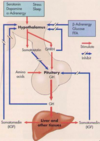S8) The HPA Axis & Growth Hormone Flashcards
Describe the relationship between the hypothalamus and the pituitary gland
The hypothalamus and pituitary gland form a complex functional unit that serves as the major link between the endocrine and nervous systems
Where is the pituitary gland found?

The hypothalamus and pituitary gland modulate a wide variety of processes.
Identify some
- Body growth
- Reproduction
- Lactation
- Thyroid & adrenal gland function
- Water homeostasis
The pituitary gland consists of two distinct parts.
What are they?

The anterior and posterior pituitary glands have distinct embryological origins.
Describe these
- Anterior pituitary gland (adenohypophysis) arises from evagination of oral ectoderm (primitive gut tissue)
- Posterior pituitary gland (neurohypophysis) originates from neuroectoderm (primitive brain tissue)
The hormones produced by nerve cells in the hypothalamus act via two distinct neurocrine pathways.
Describe these pathways
- Direct effects on distant target tissues via oxytocin and antidiuretic hormone from the posterior pituitary
- Hormones secreted exclusively into hypophyseal portal system affect endocrine cells within the anterior pituitary
In 3 steps, outline the neuroendocrine function of the posterior pituitary gland
⇒ Oxytocin and ADH are produced by neurosecretory cells in the supraoptic and paraventricular nuclei of hypothalamus
⇒ Transported down nerve cell axons to the posterior pituitary
⇒ Stored and released from posterior pituitary into the general circulation

In four steps, describe the synthesis, transport, release and action of the hormones acting on the anterior pituitary gland
⇒ Hormones synthesised in hypothalamus
⇒ Hormones transported down axons and stored in median eminence
⇒ Hormones released into hypophyseal portal system
⇒ Hormones stimulate/inhibit target endocrine cells in the anterior pituitary gland

Describe the action of the hormones produced by the anterior pituitary gland
⇒ Endocrine cells of anterior pituitary secrete a variety of hormones into the bloodstream to act on distant target cells (endocrine function)
⇒ Anterior pituitary hormones also effect neighbouring cells (autocrine and paracrine function)

Which hormones are released from the posterior pituitary gland and what do they do?
- Oxytocin – milk let down and uterine contractions during birth
- Antidiuretic hormone – regulation of body water volume
6 tropic hormones produced in the hypothalamus and have direct effects on the release of anterior pituitary hormones.
Identify them
- TRH – Thyrotropin releasing hormone / PRH
- PIH – Prolactin release-inhibiting hormone (dopamine)
- CRH – Corticotropin releasing hormone
- GnRH – Gonadotropin releasing hormone
- GHRH – Growth hormone releasing hormone
- GHIH – Growth hormone-inhibiting hormone (somatostatin)
Identify the 6 hormones produced in the anterior pituitary gland
- TSH – Thyroid stimulating hormone
- ACTH – Adrenocorticotropic hormone
- LH – Luteinising hormone
- FSH – Follicle stimulating hormone
- PRL – Prolactin
- GH – Growth hormone
Summarise the relationship between the tropic hormones of the hypothalamus and the hormones produced by the adenohypophysis as well as their respective effects

Outline the hypothalamic-pituitary-adrenal axis as an example of a negative feedback system

Growth is influenced by many factors.
Identify some of these

Growth hormone is produced in the anterior pituitary.
Describe its stimulation and inhibition
- Stimulation: hypothalamic GHRH
- Inhibition: hypothalamic Somatostatin
How do growth hormones exert their effects?
- Growth-promoting effects mainly exerted indirectly via insulin-like growth factors (somatomedins)
- In response to GH cells of the liver and skeletal muscle produce and secrete IGFs
Explain the role of GH and IGFs in bone development in childhood/teenage years as well as in adulthood
- In childhood/teenage years:
I. GH stimulates long bone growth length & width prior to epiphyseal closure (width after epiphyseal closure)
II. IGFs stimulate both bone and cartilage growth
- In adults:
I. GH & IGFs maintain muscle and bone mass and promote healing and tissue repair
II. GH & IGFs modulate metabolism and body composition
CNS regulates GH secretion via inputs into the hypothalamus affecting GHRH and somatostatin levels.
Describe some of these
- Deep sleep = surge in GH secretion
- REM sleep = ↓ GH secretion
- Exercise/stress = ↑ GH secretion
- Decreased glucose/FA = ↑ GH secretion
- Fasting = ↑ GH secretion
- Obesity = ↓ GH secretion
GH secretion is regulated by long loop and short loop negative feedback.
Describe the long loop negative feedback mechanism
Mediated by IGFs:
- Inhibit release of GHRH from hypothalamus
- Stimulate release of somatostatin from hypothalamus
- Inhibit release of GH from anterior pituitary

GH secretion is regulated by long loop and short loop negative feedback.
Describe the short loop negative feedback mechanism
Short loop negative feedback – mediated by GH itself via stimulation of somatostatin release

What is the consequence of growth hormone deficiency in childhood?
Pituitary dwarfism – proportionate type of dwarfism due to complete/partial deficiency
What are the consequences of growth hormone excess?
- In childhood – gigantism (rare, often caused by pituitary adenoma)
- In adulthood – acromegaly (large hands, feet, lower jaw)
How does GH exert its effects on cells?
GH receptors activate Janus kinases (JAKs)

There are 2 IGFs in mammals.
Describe their respective actions
- IGF1 – major growth factor in adults
- IGF2 – mainly involved in fetal growth

Binding proteins modulate the availability of IGFs.
What are the three ways in which IGFs communicate?
- Autocrine
- Paracrine
- Endocrine
IGFs act through IGF receptors (distinct from GH receptors) to modulate cell processes.
Identify four of these processes
- Hypertrophy
- Hyperplasia
- Increase in the rate of protein synthesis
- Increase in the rate of lipolysis in adipose tissue
Other hormones influence growth. Describe the growth-related actions of the following hormones:
- Insulin
- Thyroid hormones
- Androgens
- Oestrogens
- Glucocorticoids
- Insulin – enhances somatic growth; interacts with IGF receptors
- Thyroid hormones – promote CNS development and enhance GH secretion
- Androgens – accelerate pubertal growth spurt; increase muscle mass; promote closure of epiphyseal plates
- Oestrogens – decrease somatic growth; promote closure of epiphyseal plate
- Glucocorticoids – inhibit somatic growth


